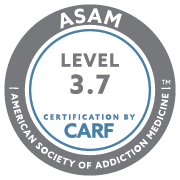Around 2.7% of adults struggle with borderline personality disorder (BPD). Approximately 78% of adults experience both a borderline personality disorder and addiction at some time.
When combined with addiction, borderline personality disorder can cause clinically less stable and more impulsive than those with BPD but without addiction. Dropping out of treatment more frequently, displaying suicidal behavior to a higher degree, and experiencing shorter abstinence periods can be common. The combination of BPD and addiction requires a unique treatment approach.
What is Borderline Personality Disorder (BPD)?
BPD is a behavioral health disorder affecting people’s thoughts and feelings about themselves and others. This disorder can cause issues with day-to-day functioning and relating with others.
BPD is frequently manifested through:
- Difficulty managing behavior and emotions
- Self-image problems
- Patterns of unstable relationships

Diagnosing BPD can be difficult, and signifying behaviors frequently come off as angry, clingy, erratic, and rude. Struggling with BPD can cause acting out for fear of being alone or rejected which can be why these behaviors can occur. Generally, BPD develops during younger adulthood and can slowly improve with age, but every case is different.
Risk Factors for BPD
The DSM-5 shows that women are diagnosed with BPD more often than men (75% vs. 25%). Other research shows there might not be a gender difference in the general population for the prevalence of BPD. However, it is linked with a substantially higher level of physical and mental disability for women than it is for men.
Presently, there isn’t an exact established cause for BPD. However, research does point out specific factors that could increase a person’s risk for developing a borderline personality disorder. These risk factors, however, don’t necessarily mean that the person will develop BPD.
2. Genetics
Individuals may be at a greater risk for developing BPD if they have a family history of mental health disorders. This is particularly true for people with immediate family members, such as parents or siblings, with BPD.
3. Past Experiences
Many people with borderline personality disorder have experienced traumatic life events. Traumatic life events can include sexual, physical, or emotional abuse, childhood adversity, and abandonment.
4. Environmental Factors
The environment of a person’s upbringing can present risk factors for BPD. Frequent hostile conflicts, a child’s family life being disrupted, and poor communication can all contribute to the development of borderline personality disorder.
What is Addiction?
Addiction is a chronic brain system dysfunction that involves motivation, reward, and memory. It concerns how the body craves a behavior or substance. Mainly it can lead to a disregard for the consequences or obsessive or compulsive pursuit of reward.
Signs of addiction can include:
- Showing a lack of self-control
- Being unable to stop the addictive behavior or stay away from the substance
- Dismissing how substance abuse could be causing issues
- Having an enhanced desire for the behavior or substance
- Lacking an emotional response

Addictions can severely disrupt or interfere with daily life. Substance abuse can cause severe consequences like bankruptcy and permanent health complications.
Risk Factors for Addiction
Individuals of all beliefs and backgrounds can experience addiction. It can be challenging to understand why specific individuals are more susceptible to addiction than others. Many factors can increase the risk of becoming addicted to drugs and alcohol.
1. Genetics
Heredity is a considerable risk factor for addiction. Up to 50% of a person’s risk of addiction to nicotine, alcohol, or drugs is based on their genetics. This data is according to the National Institute on Drug Abuse. If someone has family members who have struggled with addiction, that individual is more likely to struggle with addiction themselves.
2. Environment
A person’s risk of addiction also increases due to environmental factors. Lack of parental involvement can cause children and teens to be more likely to experiment with alcohol or drugs. Young individuals who experience parental neglect or abuse may also use alcohol or drugs to deal with emotions.
Another risk factor for addiction is peer pressure, particularly among young individuals. Even when pressure from friends isn’t aggressive or overt, it can still lead to an environment of “experimentation” with substances. In some cases, experimentation may develop into an addiction.
3. Mental Illness
Underlying mental health problems can raise a person’s risk of addiction. Also, addiction can increase a mental health condition’s severity. This generates a vicious cycle where the person’s addiction tends to progress and with severe consequences quickly.
4. Early Use
Another addiction risk factor is the age at which the individual began the behavior. Addictive behavior when a person is young can also affect their brain development. These behaviors can make them more susceptible to mental illness as they get older and their addiction worsens.
Treatment for BPD and Addiction
Borderline personality disorder and drug addiction should receive treatment as early as possible. BPD and addiction can be treated simultaneously in a rehabilitation center that offers dual diagnosis client care. These services make both drug abuse treatment and psychotherapy available for the clients.
1. Cognitive-Behavioral Therapy (CBT)
CBT helps with understanding thinking patterns that feed into impulsive behaviors. CBT can help with better control of emotions and positive coping skills. Self-medicating risks with alcohol and drugs can be reduced after participating in CBT.
2. Dialectic Behavior Therapy (DBT)
DBT is a very common treatment for substance abuse and borderline personality disorder. DBT is a therapy that helps individuals with serious mental illnesses live healthier, happier lives by balancing self-acceptance with change. It helps emotionally distressed and self-destructive clients learn how to effectively manage their emotions, even in the most challenging situations.
3. Medication
Medication for addiction, along with medication for mental health disorders, can also be a practical treatment approach. Medication is often paired with a treatment plan. Medication designed to help restore neurotransmitter balance in clients with BPD can be beneficial (selective serotonin reuptake inhibitor class of antidepressants).
Also, anti-addiction medications like Naltrexone and Suboxone can be used to help reduce the symptoms of withdrawal. These medications can also decrease the desire for drugs and alcohol.
It’s notoriously hard to treat BPD. Individuals with BPD must communicate regularly with their doctor and treatment team since they can make unreasonable demands on therapists.
Help with BPD & Addiction in Orange County
 Borderline personality disorder and addiction can commonly co-occur in women. Treating the two disorders simultaneously provides the best results for long-term recovery. Treatment can include psychotherapy and medication as needed.
Borderline personality disorder and addiction can commonly co-occur in women. Treating the two disorders simultaneously provides the best results for long-term recovery. Treatment can include psychotherapy and medication as needed.
Call New Directions For Women today if you or someone you love struggles with BPD and addiction. Our team of caring clinicians can help you or your loved one work through the addiction and treat the BPD. We provide a safe, healthy, and trusted environment with an integrated treatment plan.










